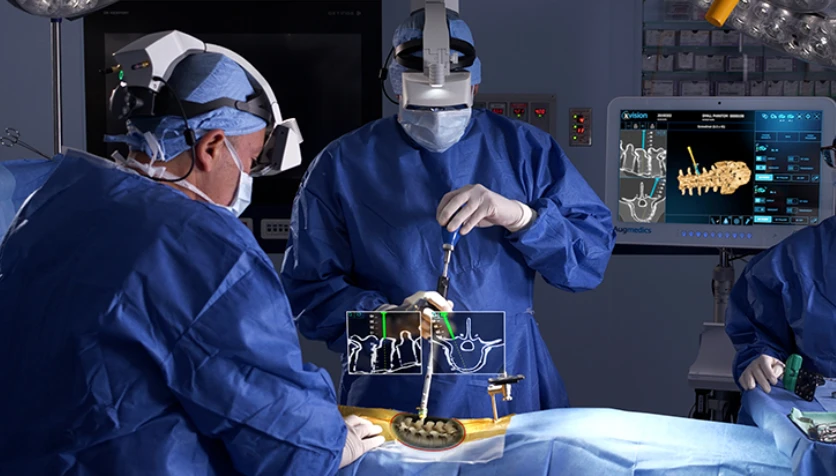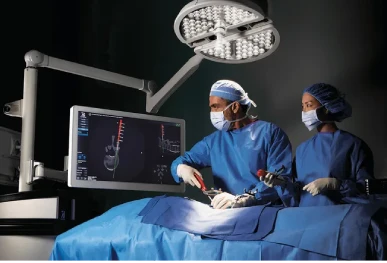
What is Navigation-Guided Bone Tumor Surgery?
Navigation-guided bone tumor surgery is a technique that uses advanced imaging and computer-assisted navigation systems to guide surgeons during the removal of bone tumors. It allows for greater precision in tumor excision and helps in minimizing damage to surrounding healthy tissue. The system uses real-time imaging (like CT or MRI scans) and integrates them into a navigation system that provides a 3D view of the affected area, enabling the surgeon to plan and execute the surgery with increased accuracy. This method is often employed in complex or challenging surgeries where the tumor is located near vital structures, or when a high degree of accuracy is required to minimize complications and ensure a complete removal of the tumor.
How It’s Done:
Preoperative Planning:
- Before the surgery, detailed imaging studies such as CT scans, MRI, or X- rays are conducted to get a clear picture of the tumor's size, location, and proximity to surrounding bone and soft tissue structures.
- These images are then processed by the navigation system to create a 3D model of the affected area, allowing the surgeon to plan the surgery in detail.
- During the surgery, the navigation system is calibrated with the patient’s body, usually by attaching markers to the skin, bone, or surgical tools.
- These markers communicate with the navigation system, which tracks the movement of instruments in real-time.
- The surgeon makes an incision in the skin to access the tumor. During the surgery, a computer-assisted navigation system is used to track the position of the surgical instruments and compare it to the preoperative plan.
- The system constantly provides feedback to the surgeon, guiding the instrument to the tumor, helping to ensure that the tumor is completely removed while minimizing harm to surrounding structures.
- The tumor is carefully excised with the help of the navigation system, which guides the surgeon to remove the tumor accurately and with minimal disturbance to the surrounding healthy bone and tissue.
- After the tumor is removed, further imaging (such as X-rays or CT scans) may be performed to ensure that all of the tumor has been excised and to confirm the position of any grafts or implants used for reconstruction.
- If necessary, bone grafts, allografts, or prostheses may be used to reconstruct the bone after tumor removal. The navigation system can also help in placing these materials accurately.
System Calibration:
Surgical Approach:
Tumor Resection:
Postoperative Imaging:
Reconstruction:
Advantages of Navigation-Guided Bone Tumor Surgery:
Increased Precision:
- Navigation systems offer high precision in identifying the tumor and removing it with minimal damage to surrounding bone and tissue. This is especially beneficial in complex or difficult-to-reach tumors.
Improved Tumor Resection:
- The ability to track the surgical instruments in real-time reduces the likelihood of leaving behind residual tumor tissue, which lowers the risk of recurrence and improves long-term outcomes.
Minimized Risk to Surrounding Structures:
- In cases where the tumor is located near vital structures (e.g., nerves, blood vessels), the navigation system ensures that these structures are preserved, reducing the risk of damage during surgery.
Reduced Surgical Time:
- With preoperative planning and real-time guidance, the surgery can be completed more efficiently, which can shorten the duration of the procedure and potentially reduce anesthesia risks.
Less Invasive:
- Navigation systems allow for more accurate and targeted incisions, which means the surgery can often be less invasive, leading to smaller scars and potentially faster recovery.
Better Outcomes in Complex Cases:
- In difficult cases, such as when the tumor is located in a challenging area or is in close proximity to critical structures, navigation-guided surgery can improve the accuracy of tumor removal and ensure a better outcome.
Enhanced Postoperative Recovery:
- By minimizing damage to surrounding healthy tissue, the patient may experience less pain, a lower risk of complications like infections, and a faster recovery time.
Real-time Feedback:
- The navigation system provides continuous, real-time feedback, ensuring that the surgeon can correct any mistakes immediately during the surgery, leading to higher precision and reduced chances of errors.
Conclusion
Navigation-guided bone tumor surgery represents a significant advancement in orthopedic surgery, offering greater precision, reducing the risk of complications, and improving outcomes for patients undergoing tumor excision. This method is particularly advantageous for tumors in complex locations or when preserving surrounding bone and tissue is critical. It also allows for better planning, more accurate tumor removal, and potentially faster recovery times for patients

